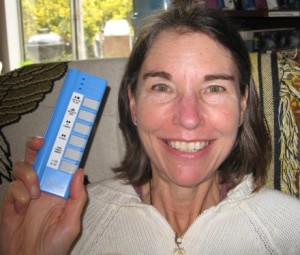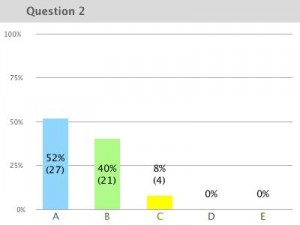I’m actually sitting in front of my classroom administering a final to my introductory psychology class (early, due to my impending travel to Greece) and thinking about the quarter. Usually by the time Spring Quarter rolls around, I feel pretty burned out and ready for a summer of reading and writing, mixed in with some much-needed attention to my garden. This year, I feel quite energized. I really enjoyed this quarter, even though I thought I might have bitten off a bit more than I could chew.
One of the contributing factors to my increased fun level was the incorporation of iClicker technology into my introductory and biological psychology courses. I had wanted to do this for a long time, but felt there were some barriers. Now that the technology has stabilized, the time seemed right. Plus, I needed to write audience response questions for the Instructor’s Manual for my textbook, Discovering Biological Psychology, and I figured it would be silly to attempt this unless I had some first-hand experience.

The Instructor's Blue Version of the iClicker
Here are the pros I found for using iClickers. The students like the technology, even though it costs them extra money. If you space your questions throughout a lecture (every ten minutes or so), it really helps everyone to stay awake, even at 8am. Another huge plus is that it is an easy, unobtrusive way to take attendance. Cal Poly, unlike many state universities, prides itself on its relatively small class sizes. My iClicker-using classes have 61 and 67 students respectively in spite of their status as General Ed courses, but that’s still way to large to have an effective means of taking attendance. Even more importantly, I can ask questions that I would NEVER ask my students by show of hands, because you can gather data anonymously. This quarter, I learned that 40% of my students do not believe in evolution and 60% have vomited after drinking alcohol.

The Technology Captures Your PowerPoint Slide As a JPEG

And Then Displays the Results As a Bar or Pie Chart: This graph can be made visible to your class, and used to stimulate discussion.
On the minus side, I found that some students simply did not understand the implications of “10 percent of your grade.” I set my point loads for my clicker questions a bit higher than most users recommend (most use 5%), because I had been concerned about my attendance. In previous quarters, I had collected spot check attendance sign-ins, and found a very high correlation between attendance and ultimate performance in the class. I was hoping that if students knew attendance would really matter, they would do better. They didn’t. The average student had about 75% of the possible clicker points, and some had as few as 20%. Perhaps this is just something that will resolve once word gets around on polyratings (our version of ratemyprofessor) that getting your clicker points does make a difference in your grade.
In the meantime, I would love to hear back from students and faculty about using audience response systems, and ways I can improve my use of the technology.


1 Comment
ericabashaw · June 4, 2009 at 6:57 pm
I thought the syllabus was pretty clear about the iclickers. But perhaps students confused the “thanks for playing” points and points for credit. Maybe they simply assumed clickers were for extra credit…
I thought they were helpful. As interesting as biopsych is, it’s easy to nod off when you’ve only had 4 hours of sleep and too little coffee. iClickers give you an incentive to truly pay attention and NOT put off learning the material until “later” (whenever that may be).
With that said, thank you for a great quarter! I really enjoy your blog–it’s on my RSS reader. 🙂
Comments are closed.